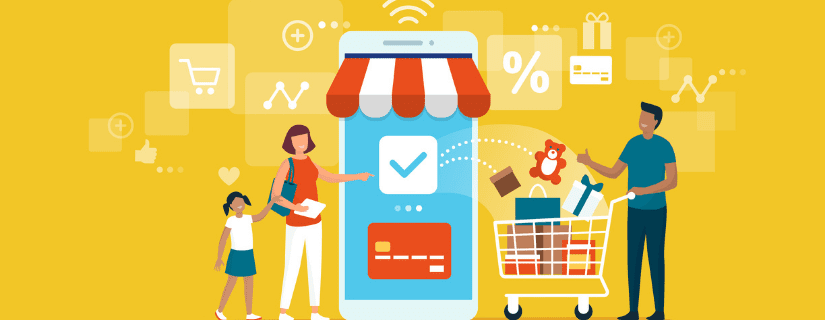
When running a business, it’s essential to stay ahead of ecommerce trends to boost sales and grow your brand.
One of the many impacts of COVID-19 was the acceleration of ecommerce growth. According to McKinsey, 10 years of development happened in just three months. Even now, 46 percent of consumers remain uncomfortable in bricks and mortar stores.
With the boom in online shoppers came a boom in online businesses. To continue to stand out in the ecommerce industry, you need to deliver seamless customer journeys and unique experiences. Staying on top of new ecommerce trends is more important than ever.
Hear from small business owners, marketers, and trend forecasters on the most important ecommerce trends emerging right now. Discover practical ways to use these trends to deliver standout service to your customers and expand your business.
1. Mobile
We’ve been talking about the rise of mobile in online purchasing trends for years. Now, Statista says mobile devices account for nearly 31 percent of all ecommerce sales. The future of ecommerce is mobile.
Top tip
“To prepare for the growth of mobile shopping, make sure your ecommerce website is responsive. Menus, text, images, elements, and widgets should display properly across all screen sizes, “ says Sam Stein, search engine marketing professional at eSafetyFirst.
Martin Orefice, founder of Rent To Own Labs, says a good place to start is to test your site’s mobile readiness on Google’s Mobile-Friendly Test Tool.

Continue the good work by always checking mobile view before hitting send on your newsletters.
2. Augmented reality
One of the big drawbacks of online stores used to be that customers couldn’t see or size up the product. But with augmented reality, that’s no longer true. All your customers need to beam your products into their home is a mobile device.
“Using their smartphone camera, customers can walk around [your product], watch a moving demo, and see its features up close as though it were on their kitchen counter,” says Shivvy Jervis, trend forecaster and founder of the FutureScape 248 Lab.
Top tip
Use AR to recreate the in-store buying journey or enable users to have a personalized experience of your product in their home. Like Gantri, walk subscribers through the features in your newsletter to drum up interest and boost sales.

3. Personalization
Personalization is all about making sure your customers feel special, not spammed.
Address your customer by their name. Improve your customer experience with product recommendations based on their location or previous purchases. Focus on being as helpful as possible with information, special offers, and exclusive discounts curated for them.
Top tip
Personalize your ecommerce email marketing using field insertion. Automatically add the customer’s name in the subject line and as an opening greeting. It’s simple but can increase open rate metrics by around 20 percent and sales by 31 percent.
To tap into the full potential of this marketing tool, personalize your special offers and the timing of your emails.
Ella, founder of the low sugar cake store FitBakes, explains: “We divide our clients into segments by preference and purchase history. The ones that like chocolate receive an email whenever there’s a promotion on chocolate. The ones that prefer citrus flavors get emails when it’s sunny. The ones that usually buy on payday get an email between the 29th and the 1st of the month.”
FitBakes recently sent an email promoting their jaffa cakes to customers who viewed, bought, or added the product to their cart in the last three months. The team excluded those who had placed an order in the previous week. The email generated $2,200 in sales.
Ella sums up, “If you make them feel special, they come back over and over.”

For more about personalization related to your Shopify store, check out our article on the best email marketing for Shopify.
4. The new influencer
Influencer marketing, many retailers’ secret weapon, is expected to grow by 12% to over $4 billion next year. But as anyone who has seen yet another reality TV star pushing diet tea on Instagram will know, it can sometimes feel a little inauthentic. And you’re always at the mercy of the platform’s algorithms.
Now a more organic and community-oriented approach to the influencer is on the rise. This takes two guises.
1. Employee as influencer
Connect with your clients by introducing your ecommerce store through omnichannel behind-the-scenes content. Customers feel they’re getting exclusive access which amplifies your product’s value and generates sales.
2. Micro-influencers
Scope out micro-influencers in your niche. They have a smaller following but because they are less expensive to hire and their audience is more specific you have a better chance of getting a good return on your investment.
Top tip
A quick way to action this in your email marketing is to find a more authentic voice in your copy. Write emails from your founder, include a photo, and sign off as yourself as Beardbrand does in this example. It helps your reader feel special and build an affinity with your brand.

Video is a fantastic tool for this more personal approach to influencer marketing. Harriet, co-founder of CocoFinder, made videos of team members using CocoFinder products. “Our customers found this video exciting. We noticed an 89 percent improvement in click rate.”
Play with building newsletters and social campaigns around editorial content, day-in-the-life features, and brand challenges involving your community.
5. Sustainability
In 2019, 73 percent of shoppers would change their consumption habits to reduce their environmental impact. Since the coronavirus pandemic last year, it’s estimated this figure will be even higher.
Make your business more sustainable to build a strong brand reputation, regenerate the planet and make cost savings.
It can be daunting if it’s your first time reviewing your sustainability policy. Start small with just one or two changes. Be transparent about your wins, how far you’ve come, and where you hope to go.
Top tip
There are three options to consider when making ethical or sustainable changes to your business.
1. Your materials
Switch to eco-friendly packaging for ecommerce. It’s a consumer-facing way to reduce your environmental impact and save money.
Clean up your supply chain. Where could you reduce your carbon footprint within your raw materials, manufacturers, and service providers?
Think about your product’s afterlife. Offer repair services or buy-back schemes to keep materials in circulation rather than landfills.
2. Your resources
Donate resources to tackle inequality. Shoe brand Toms built their brand on a policy to donate one pair of shoes for every pair purchased.
3. Give time and skills
Give your time or skills to supporting a cause that feels relevant.
Whichever route you choose, your sustainable policies become a talking point for your marketing strategy.

6. Virtual events
Virtual events have boomed since the Covid-19 pandemic. 55 percent of virtual event organizers plan to invest more in virtual events in 2023 than ever before.
Virtual events help you connect with people offline and boost your ecommerce sales. You can also reach people beyond your local area and create strong global ties to your brand and your products.
Top tip
Think about who your ecommerce brand is for and what they might need. If you’re targeting stressed-out parents, put on a virtual yoga class. If your audience is students, support them with virtual study sessions or CV workshops.
Use your newsletter to promote the event as it approaches and document it once it’s finished.

7. Video
Video is becoming an essential tool for ecommerce platforms. Anything interactive which tells a story is a hit with customers. Laura Fuentes, operator of Infinity Dish, says, “We started creating video content for our social media platforms and saw a significant increase in shares and likes.”
Top tip
Get creative with your video content.
- Show your new products in action
- Share the process behind how you make your bestselling item
- Introduce a specific aspect of your service

With Brevo, you can insert an image or still into your email with a link to your video. This avoids any issues with deliverability and ensures your readers have no trouble viewing your content regardless of the email client they use. You can then conveniently link to the relevant products from the video.
8. Free shipping
73 percent of customers want it. And thanks to the Amazon effect, more and more ecommerce businesses offer it. Free shipping.
We’ve seen this perk explode as the online shopping trend boomed and people remained stuck at home. For new and growing businesses, it’s a great way to turn abandoned carts into checkouts.
Top tip
Set a minimum spend to protect your business from making a loss on small orders and you’re ready to go.
Shout about your new free shipping policy in your email strategy. Boost your conversions with an automated abandoned cart email reminding your customers they don’t have to pay shipping on their left items.
To set up your own abandoned cart emails and more, check out Brevo’s ecommerce email marketing software.

9. Subscriptions
When it comes to payment options, subscriptions are an emerging trend.
“The subscription model offers what consumers today are craving: value for money, convenience, and exclusive perks,” says Eden, marketing director and founder of WeInvoice. And for you, the brand, it means regular guaranteed income and predictable stock flow.

Top tip
“The most popular subscriptions hook us on one or even two of the three ‘S’s: security, savings, surprise,” says Tim Lewis for the Guardian. Think about how your subscription model could make your customer’s life easier, save them money, or give them a moment of joy in their day.
James Crawford, co-founder of DealDrop, recommends starting a subscriber newsletter to deliver updates and offers that keep customers involved.
10. Voice search
Jon Buchan, CEO of Charm Offensive, says, “Nearly 5.5 million online shoppers in the US make voice-based purchases regularly. And according to a forecast, nearly 75 percent of American households will buy a smart speaker by 2025.”
Top tip
Adapt your existing search engine optimization (SEO) strategy for voice search. “Include conversational-style search terms,” says Daniel Foley, SEO manager at Halcyon School.
11. Chat
According to Shopify’s Future of Commerce report, Conversational Commerce is a powerful tool to smash sales targets.
And if keeping up with your millennial consumers on your ecommerce site’s live chat is proving a challenge, there’s AI. Advances in artificial intelligence mean chatbots are now more capable of dealing with a wider range of queries.
Top tip
Back up your live chat function with a chatbot to handle basic queries and give response times. Promote this service by dropping a link into your email marketing.
12. Shopify trends
According to Shopify, 50 percent of consumers want to move away from big retailers and marketplaces. They are ready to support smaller ecommerce brands and D2C retailers.
Top tip
Seize this golden opportunity to help customers feel good about their spending. Match the big hitters on convenient perks like free delivery and returns and speedy shipping. Check out our selection of the best Shopify apps that will help you level up your store.
Final tips on ecommerce trends
There’s a lot to gain in the ecommerce space right now. As we emerge from the pandemic, leverage ecommerce trends to
- Appeal to consumers looking for a new way to shop
- Make new and returning customers feel valued
- Improve the ease and convenience of their buying experience
As you develop your offering, use your newsletter to promote new products and services and build relationships with your customer community.
For more content like this, sign up for our monthly marketing tips newsletter and follow us on Twitter.






